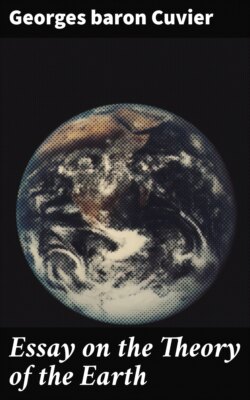Читать книгу Essay on the Theory of the Earth - Georges baron Cuvier - Страница 9
На сайте Литреса книга снята с продажи.
Proofs that such revolutions have been numerous.
ОглавлениеTable of Contents
But it is not to this subversion of the ancient strata, nor to this retreat of the sea after the formation of the new strata, that the revolutions and changes which have given rise to the present state of the Earth are limited.
When we institute a more detailed comparison between the various strata and those remains of animals which they contain, we presently perceive, that this ancient sea has not always deposited mineral substances of the same kind, nor remains of animals of the same species; and that each of its deposits has not extended over the whole surface which it covered. There has existed a succession of variations; the former of which alone have been more or less general, while the others appear to have been much less so. The older the strata are, the more uniform is each of them over a great extent; the newer they are, the more limited are they, and the more subject to vary at small distances. Thus the displacements of the strata were accompanied and followed by changes in the nature of the fluid, and of the matters which it held in solution; and when certain strata, by making their appearance above the waters, had divided the surface of the seas by islands and projecting ridges, different changes might take place in particular basins.
Amidst these variations in the nature of the general fluid, it is evident, that the animals which lived in it could not remain the same. Their species, and even their genera, changed with the strata; and, although the same species occasionally recur at small distances, it may be announced as a general truth, that the shells of the ancient strata have forms peculiar to themselves; that they gradually disappear, so as no longer to be seen at all in the recent strata, and still less in the presently existing ocean, in which their corresponding species are never discovered, and where several, even of their genera, do not occur: that, on the contrary, the shells of the recent strata are similar, in respect to their genera, to those which exist in our seas; and that, in the latest and least consolidated of these strata, and in certain recent and limited deposits, there are some species which the most experienced eye could not distinguish from those which are found in the neighbouring seas.
There has, therefore, been a succession of variations in the economy of organic nature, which has been occasioned by those of the fluid in which the animals lived, or which has at least corresponded with them; and these variations have gradually conducted the classes of aquatic animals to their present state, till, at length, at the time when the sea retired from our continents for the last time, its inhabitants did not differ much from those which are found in it at the present day.
We say for the last time, because, if we examine with still greater care those remains of organised bodies, we discover, in the midst of even the oldest strata of marine formation, other strata replete with animal or vegetable remains of terrestrial or fresh-water productions; and, amongst the more recent strata, or, in other words, those that are nearest the surface, there are some in which land animals are buried under heaps of marine productions. Thus, the various catastrophes which have disturbed the strata, have not only caused the different parts of our continents to rise by degrees from the bosom of the waves, and diminished the extent of the basin of the ocean, but have also given rise to numerous shiftings of this basin. It has frequently happened, that lands which have been laid dry, have been again covered by the waters, in consequence either of their being ingulphed in the abyss, or of the sea having merely risen over them. The particular portions also, of the Earth, which the sea abandoned in its last retreat,—those which are now inhabited by man and terrestrial animals,—had already been once laid dry, and had then afforded subsistence to quadrupeds, birds, plants, and land productions of all kinds: the sea which left it had, therefore, covered it at a previous period[4].
The changes in the level of the waters have not, therefore, consisted solely in a more or less gradual, or more or less general retreat; there have been various successive irruptions and retreats, the final result of which, however, has been a universal depression of the level of the sea.
